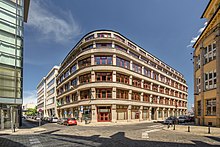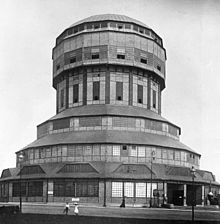Hans Poelzig
Hans Poelzig | |
|---|---|
I.G. Farben Building Haus des Rundfunks in Charlottenburg | |
| Projects | Palace of the Soviets Film sets for The Golem |
Hans Poelzig (30 April 1869 – 14 June 1936) was a German architect, painter and set designer.
Life
Poelzig was born in Berlin in 1869 to Countess Clara Henrietta Maria Poelzig while she was married to George Acland Ames, an Englishman. Uncertain of his paternity, Ames refused to acknowledge Hans as his son and consequently he was brought up by a local choirmaster and his wife. In 1899 he married Maria Voss with whom he had four children.[1]
His mother was the daughter of
Education
In 1903 he became a teacher and director at the Breslau Academy of Art and Design (German: Kunst- und Gewerbeschule Breslau; today in Wrocław, Poland). From 1920–1935 he taught at the Technical University of Berlin (Technische Hochschule Berlin).
Career
After finishing his architectural education around the turn of the century, Poelzig designed many industrial buildings. He designed the 51.2-metre-tall (168 ft) Upper Silesia Tower in Posen (today Poznań) for an industrial fair in 1911. It later became a water tower. He was appointed city architect of Dresden in 1916. He was an influential member of the Deutscher Werkbund.
Poelzig was also known for his distinctive 1919 interior redesign of the Berlin Grosses Schauspielhaus for Weimar impresario
With his Weimar architect contemporaries like


Poelzig's single best-known building is the enormous and legendary
In 1933 Poelzig served as the interim director of the United State School for Fine and Applied Art (Vereinigte Staatsschulen für freie und angewandete Kunst), after the expulsion of founding director Bruno Paul by the National Socialists.
In 1935 Poelzig received first prize for a theater and concert hall in Istanbul, Turkey, where he was also planning to teach. On November 30 that year, age 65, he retired from the Director of the Architecture Department of the Prussian Academy of Arts in Berlin. While preparing to move to Turkey, on 14 June 1936, Hans Poelzig died of a stroke. He was buried in the Old Wannsee Cemetery. [de ]
In 1937 his wife had to close her studio under pressure from the National Socialists.

Legacy
On 18 November 2015, Friedrichstadt-Palast Berlin inaugurated a memorial at Friedrichstraße 107 dedicated to the theatre's founders, Max Reinhardt, Hans Poelzig and Erik Charell.
Work

Buildings
- 1901 Church spire, Wrocław[2]
- 1904 A Family house with garden pavilion for the arts and crafts exhibition
- 1908 Dwelling houses, corner of Menzelstraße and Wölflstraße in Breslau, (now Sztabowa/Pocztowa, Wrocław)
- 1908 Dwelling house, Hohenzollernstraße, Breslau (no longer standing)
- 1907 – c. 1909: mixed commercial offices and retail, Hohenzollernstraße, Wrocław (no longer standing)
- 1911 Sulphuric acid factory in Luboń
- 1911 Grain silo and Roofed Marketplace in Luboń
- 1911 Exhibition Hall and Tower in Poznań for an industrial fair (destroyed)
- 1912 Department store in Junkernstrasse, Wrocław (now ul. Ofiar Oświęcimskich)
- 1913 Four Domes Pavilion, Wrocław (now part of UNESCO World Heritage Site "Centennial Hall")
- 1919 Grosses Schauspielhaus, in Berlin
- 1920 Festival Theater for Salzburg
- 1924 Office building, Hanover
- 1927 Deli cinema, Wrocław (now demolished)
- 1929 Haus des Rundfunks (Radio Station), Charlottenburg, Berlin
- 1929 Kino Babylon, Mitte, Berlin [3]
- 1931 I.G. Farben Building in Frankfurt
Projects
- Palace of the Soviets
- League of Nations
- 1920 – Film sets for The Golem: How He Came into the World
- 1921 – Friedrichstraße Station Skyscraper competition in Berlin
- 1925 – Capitol, cinema, Berlin
- 1926 – German Forum for Sport, Berlin
Citations
- ^ Dawson, p.96
- ^ The church spire of the Hofkirche at archINFORM
- ^ "Kino Babylon". slowtravelberlin.com. Retrieved 20 April 2018.
References
- ISBN 978-3-933713-63-6
- Dawson, Layla (May 2008). "Prolific Poelzig". The Architectural Review. CCXXIII (1335): 96–97.
- Hans Poelzig (2000): Hans Poelzig in Breslau: Architektur und Kunst 1900–1916, Aschenbeck & Holstein, ISBN 3-932292-30-8(German edition)
- Julius Posener, Kristin Feireiss (1992): Hans Poelzig: Reflections on His Life and Work, The MIT Press, ISBN 0-262-16127-3
- Kenneth Frampton (2007): The Evolution of 20th Century Architecture: A Synoptic Account, Springer Vienna Architecture, ISBN 3-211-31195-5
- Heike: Hambrock (2005): Hans und Marlene Poelzig. Bauen im Geist des Barock. Architekturphantasien, Theaterprojekte und moderner Festbau (1916–1926), Aschenbeck & Holstein Verlag, Berlin, ISBN 3-932292-80-4, (German edition)
- Hanno-Walter Kruft (1996): History of Architectural Theory, Princeton Architectural Press, ISBN 1-56898-010-8
External links
- His works in library of TU Berlin
- Industry buildings
- Film production design sketches on the European Film Gateway
